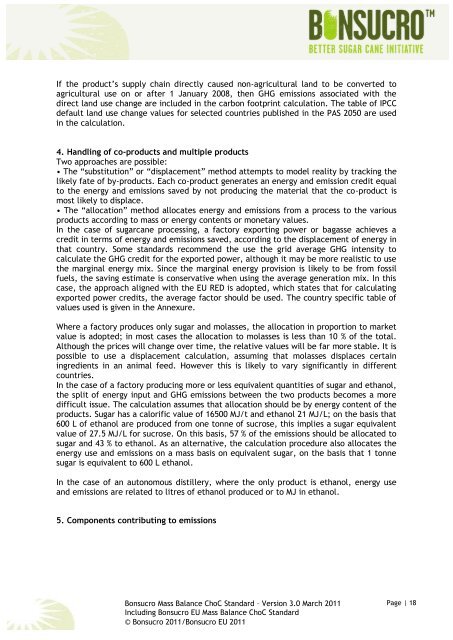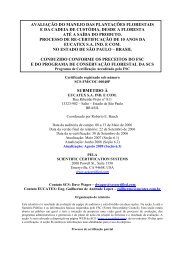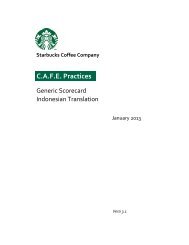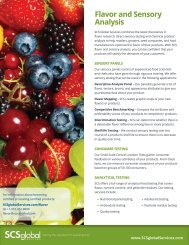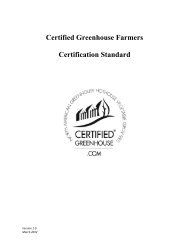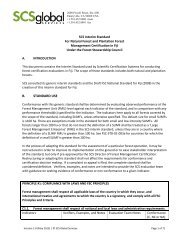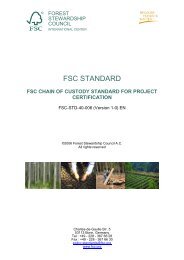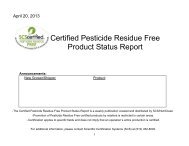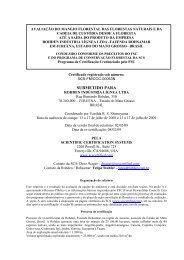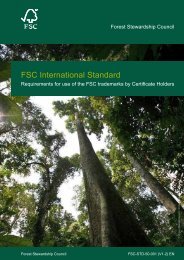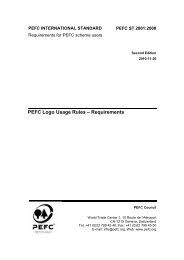CHAIN OF CUSTODY STANDARD - SCS Global Services
CHAIN OF CUSTODY STANDARD - SCS Global Services
CHAIN OF CUSTODY STANDARD - SCS Global Services
Create successful ePaper yourself
Turn your PDF publications into a flip-book with our unique Google optimized e-Paper software.
If the product‘s supply chain directly caused non-agricultural land to be converted toagricultural use on or after 1 January 2008, then GHG emissions associated with thedirect land use change are included in the carbon footprint calculation. The table of IPCCdefault land use change values for selected countries published in the PAS 2050 are usedin the calculation.4. Handling of co-products and multiple productsTwo approaches are possible:• The ―substitution‖ or ―displacement‖ method attempts to model reality by tracking thelikely fate of by-products. Each co-product generates an energy and emission credit equalto the energy and emissions saved by not producing the material that the co-product ismost likely to displace.• The ―allocation‖ method allocates energy and emissions from a process to the variousproducts according to mass or energy contents or monetary values.In the case of sugarcane processing, a factory exporting power or bagasse achieves acredit in terms of energy and emissions saved, according to the displacement of energy inthat country. Some standards recommend the use the grid average GHG intensity tocalculate the GHG credit for the exported power, although it may be more realistic to usethe marginal energy mix. Since the marginal energy provision is likely to be from fossilfuels, the saving estimate is conservative when using the average generation mix. In thiscase, the approach aligned with the EU RED is adopted, which states that for calculatingexported power credits, the average factor should be used. The country specific table ofvalues used is given in the Annexure.Where a factory produces only sugar and molasses, the allocation in proportion to marketvalue is adopted; in most cases the allocation to molasses is less than 10 % of the total.Although the prices will change over time, the relative values will be far more stable. It ispossible to use a displacement calculation, assuming that molasses displaces certainingredients in an animal feed. However this is likely to vary significantly in differentcountries.In the case of a factory producing more or less equivalent quantities of sugar and ethanol,the split of energy input and GHG emissions between the two products becomes a moredifficult issue. The calculation assumes that allocation should be by energy content of theproducts. Sugar has a calorific value of 16500 MJ/t and ethanol 21 MJ/L; on the basis that600 L of ethanol are produced from one tonne of sucrose, this implies a sugar equivalentvalue of 27.5 MJ/L for sucrose. On this basis, 57 % of the emissions should be allocated tosugar and 43 % to ethanol. As an alternative, the calculation procedure also allocates theenergy use and emissions on a mass basis on equivalent sugar, on the basis that 1 tonnesugar is equivalent to 600 L ethanol.In the case of an autonomous distillery, where the only product is ethanol, energy useand emissions are related to litres of ethanol produced or to MJ in ethanol.5. Components contributing to emissionsBonsucro Mass Balance ChoC Standard – Version 3.0 March 2011Including Bonsucro EU Mass Balance ChoC Standard© Bonsucro 2011/Bonsucro EU 2011Page | 18


